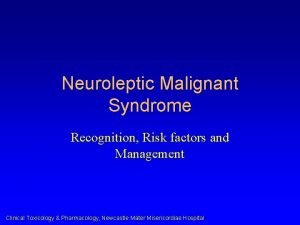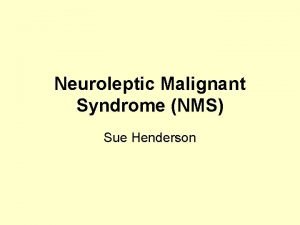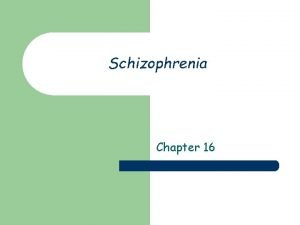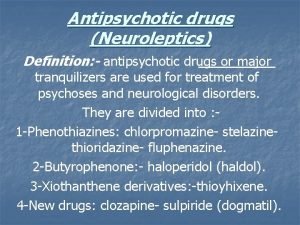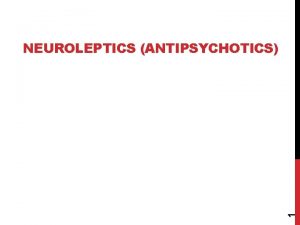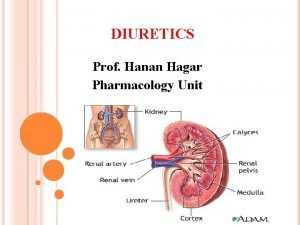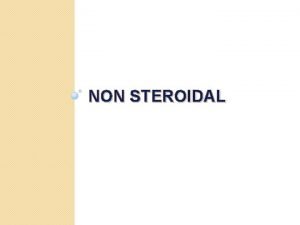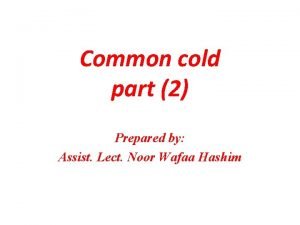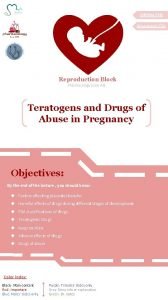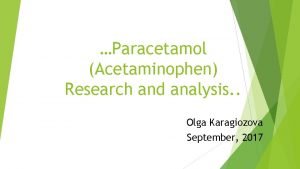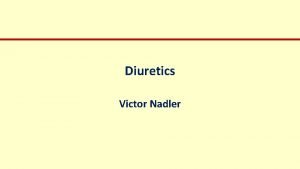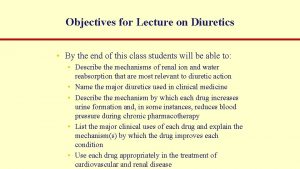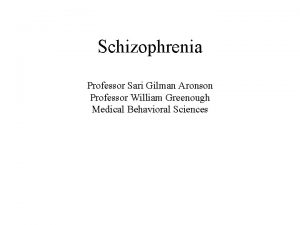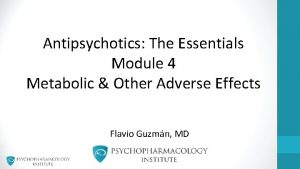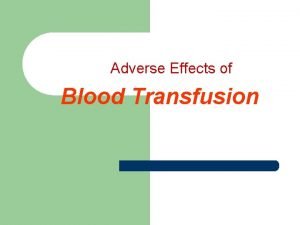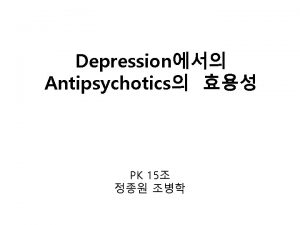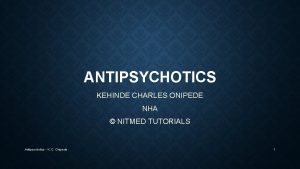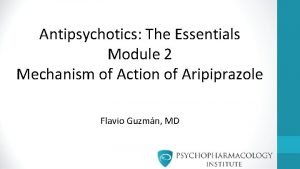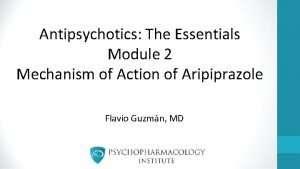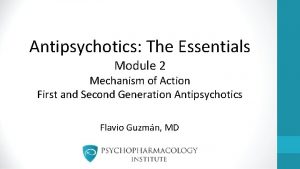Antipsychotics The Essentials Module 4 Adverse Effects Neuroleptic













- Slides: 13

Antipsychotics: The Essentials Module 4: Adverse Effects Neuroleptic Malignant Syndrome Flavio Guzmán, MD

Outline • Neuroleptic Malignant syndrome – Epidemiology – Associated drugs – Risk Factors – Clinical Manifestations – Pathophysiology – Differential Diagnosis – Management

“ NMS is an acute disorder of thermoregulation and neuromotor control carrying a mortality rate of about 21% when untreated” Janicak, P G. , Marder S R. , and. Pavuluri M N. Principles and Practice of Psychopharmacotherapy. 5 th ed. Philadelphia: Lippincott Williams & Wilkins, 2010.

NMS - Epidemiology • Estimates of incidence were once around 3% • Recent statistics suggest incidence of 0. 01 0. 02% • The syndrome has been described in all age groups (most are young adults) Strawn JR, Keck PE, Jr. , Caroff SN. Neuroleptic malignant syndrome. The American Journal of Psychiatry 2007; 164: 870 -6.

Dopamine antagonists NMS - Associated Drugs Antipsychotics Antiemetics FGA SGA High potency Low potency E Wijdicks (2011). Neuroleptic Malignant Syndrome In: Michael J Aminoff. (Ed. ), Up. To. Date. http: //uptodate. com

NMS - Risk Factors • Dehydration is present in about 92 % of patients ( risk factor or early complication? ) • Concomitant lithium use • Use of high potency agents • Long-acting injections • High antipsychotic dose (not dose dependent) E Wijdicks (2011). Neuroleptic Malignant Syndrome In: Michael J Aminoff. (Ed. ), Up. To. Date. http: //uptodate. com

NMS - Clinical Manifestations Hyperthermia Rigidity • Higher than 38°C, even higher than 40°C • Typical: “lead pipe rigidity” NMS Mental Status Changes Autonomic Instability • Agitated delirium with confusion • Tachycardia, tachypnea, labile or high BP E Wijdicks (2011). Neuroleptic Malignant Syndrome In: Michael J Aminoff. (Ed. ), Up. To. Date. http: //uptodate. com

Lab Testing - Serum CK: - More than 1, 000 UI (has high as 100, 000 UI) - Not specific for NMS - Degree of elevation correlates w/ disease severity and prognosis - Other abnormalities - Leukocytosis - Electrolyte abnormalities E Wijdicks (2011). Neuroleptic Malignant Syndrome In: Michael J Aminoff. (Ed. ), Up. To. Date. http: //uptodate. com

NMS - Pathophysiology • Unknown • Dopamine antagonism might be involved Hypothalamus Nigrostriatal pathway: Rigidity Hypothalamus: Hyperthermia Frontal lobe / Mesocortical blockade : altered mental status Strawn JR, Keck PE, Jr. , Caroff SN. Neuroleptic malignant syndrome. The American Journal of Psychiatry 2007; 164: 870 -6.

NMS – Differential Diagnosis Related Disorders Serotonin Syndrome Unrelated Disorders Heatstroke Malignant Catatonia CNS infections (Viral Encephalitis) E Wijdicks (2011). Neuroleptic Malignant Syndrome In: Michael J Aminoff. (Ed. ), Up. To. Date. http: //uptodate. com

Management of NMS • General – Stop causative agent – Supportive care • Specific agents (limited evidence) – Dantrolene – Bromocriptine – Amantadine • ECT Strawn JR, Keck PE, Jr. , Caroff SN. Neuroleptic malignant syndrome. The American Journal of Psychiatry 2007; 164: 870 -6.

Key Points • NMS is a potentially life-threatening complication of antipsychotic drug use. • Treatment with high potency FGAs at high doses increases risk. • Clinical manifestations include: mental status changes, rigidity, hyperthermia and autonomic instability. • Serum CK levels greater than 1000 IU/L are suggestive of NMS. • If NMS is suspected, antipsychotics should be discontinued immediately.

References and Further Reading • Janicak, P G. , Marder S R. , and. Pavuluri M N. Principles and Practice of Psychopharmacotherapy. 5 th ed. Philadelphia: Lippincott Williams & Wilkins, 2010. • Strawn JR, Keck PE, Jr. , Caroff SN. Neuroleptic malignant syndrome. The American Journal of Psychiatry 2007; 164: 870 -6. • E Wijdicks (2011). Neuroleptic Malignant Syndrome In: Michael J Aminoff. (Ed. ), Up. To. Date. http: //uptodate. com
 Neuroleptic malignant syndrome
Neuroleptic malignant syndrome Malignant neuroleptic syndrome
Malignant neuroleptic syndrome Nursing care plan for schizophrenia pdf
Nursing care plan for schizophrenia pdf Neuroleptics
Neuroleptics Atypical antipsychotics drugs
Atypical antipsychotics drugs Diuretic side effects
Diuretic side effects Paracetamol dose child per kg
Paracetamol dose child per kg Hayanil drug
Hayanil drug Tradjenta to januvia conversion
Tradjenta to januvia conversion Drugs that don't cross placenta mnemonic
Drugs that don't cross placenta mnemonic Effects of paracetamol
Effects of paracetamol Harley nadler
Harley nadler Loop diuretics adverse effects
Loop diuretics adverse effects Antipsychotics brain damage
Antipsychotics brain damage
